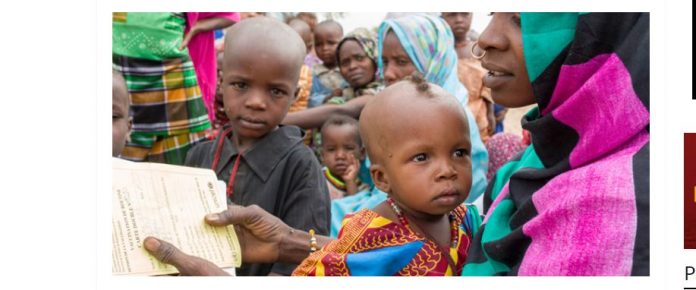So far in 2020, the COVID-19 pandemic has claimed thousands of lives across Africa. The continent’s polio teams – the extensive network of healthcare workers, laboratory experts, data managers and community volunteers – were some of the first on the ground to support the response and help contain national outbreaks.
This is not the first time the polio programme has quickly pivoted to respond to a major or emerging public health event.
Since the 1990s, the polio programme has brought the largest influx of public health expertise and funding across all countries in Africa. Polio teams and infrastructure have not only fought polio, they’ve contributed significantly to Africa’s public health and outbreak response.
Demonstrating the importance of data for disease eradication
The polio programme has recognised the critical value of data in eradicating diseases and invested heavily in systems for data collection, management and usage. This includes gathering information on communities in need of vaccination, transport of laboratory samples, health worker movements and vaccine stocks. This data-driven approach is vital for other disease interventions, says Dr Ticha Muluh, Polio Surveillance Officer at the WHO Regional Office in Africa (WHO AFRO). “The polio programme used data to constantly redirect or innovate around activities. For any programme aiming for eradication of diseases, robust data should be key.”
Reaching every child with vaccines
Polio immunization activities have pushed the boundaries of what can be achieved through vaccination campaigns.
“Historically, routine vaccination was meant to achieve a certain level of population immunity to stop outbreaks but not enough for disease elimination,” says Dr Pascal Mkanda, Polio Eradication Coordinator for WHO AFRO. “But when countries saw how successful the polio programme was in using supplemental immunization activities for disease eradication, they started learning how to move beyond the reach of routine immunization systems towards the accelerated elimination of measles, yellow fever and others building on the experience of polio.”
In Nigeria and the Lake Chad region – regions that face particular challenges in routine immunization – the specialised approaches of the polio programme are used to reach remote island communities. In DRC, strategies to address a polio outbreak along the Congo River were adapted for routine immunization, while in Nigeria and South Sudan, negotiations with armed forces have enabled access to communities with routine immunization services, following the example of polio campaigns.
Today, almost 90% of WHO immunization staff in the African region are funded by the polio programme. Fragile states in particular are heavily dependent on polio infrastructure and funding for routine immunization and disease surveillance. With the expected decline in Africa’s polio funding, continued investment will be needed to protect this legacy to ensure universal access to immunization.
Strengthening disease surveillance and laboratory networks
The polio eradication effort has built a robust and sensitive epidemiological surveillance system in the African region, with a network of well-equipped laboratories and thousands of specially trained personnel – from virologists to local community health workers detecting suspected polio cases on the ground. Over the years, these systems have been used to detect other disease outbreaks and rapidly respond to contain their spread, particularly in areas with weaker health systems.
In the 1990s, as a result of weak public health surveillance across Africa, many countries in the region experienced multiple disease outbreaks, including cholera, measles and meningitis. The polio programme’s system for detecting and responding to cases of suspected polio was used to develop an Integrated Disease Surveillance and Response (IDSR) strategy that brought together surveillance, laboratory work and other data to coordinate responses to outbreaks across Africa.
The region-wide polio laboratory and field surveillance network has also served as a model for case-based surveillance, transportation of specimens and laboratory diagnoses. The region’s measles and rubella laboratory networks set up in the 2000s were based on the polio model, and are able to confirm diseases, sometimes within hours.
Building Africa’s health workforce
The polio programme has helped to fill one of the biggest gaps in Africa’s healthcare systems: a shortage of skilled health workers. The continent is home to 11% of the world’s population and carries 24% of the global burden of disease. Yet, it has only 3% of the world’s healthcare workers.
Thousands of healthcare workers and community members have been trained as part of polio surveillance and immunization campaigns. These staff have been pivotal in strengthening routine vaccination and in delivering new vaccines and other treatments during polio campaigns. For example, polio staff in Angola have distributed vitamin A tablets as well as treated mosquito nets. In Chad, polio teams have taken a central role in rolling out yellow fever and meningitis vaccines.
Beyond vaccination and treatment handouts, polio personnel have used their particular expertise in preparedness and disease surveillance in other major outbreaks over the last 20 years, including recurrent outbreaks of plague in Madagascar and the recent Ebola outbreaks in Nigeria and in DRC.
Reaching communities through social mobilisation, communication
The polio programme in Africa, as with elsewhere, has faced difficulties in gaining the trust of communities. In remote, marginalized or conflict-ridden communities, lack of awareness about health often comes with suspicion of government and NGO activities. In particular, the polio programme has faced vaccine refusal due to rumours and misinformation.
Early on, the polio programme largely relied on posters, radio and television advertising to announce vaccination days, which often failed to resonate in communities with low literacy or little access to media. The programme quickly developed better strategies and moved to targeted communication, known as ‘social mobilization.’ Thousands of volunteers, mostly women, were recruited from within communities to speak with caregivers about the importance of polio vaccination for their children. Their local knowledge helped increase communities’ acceptance of vaccines and helped polio programmes tailor their communication strategies.

















